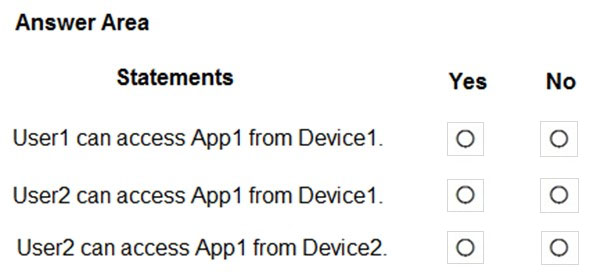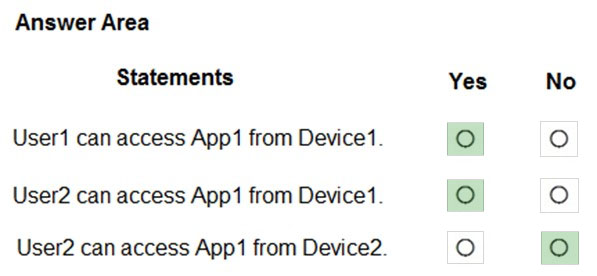

HOTSPOT -
You have a Microsoft 365 subscription that uses a default domain named contoso.com. The domain contains the users shown in the following table.
The domain contains the devices shown in the following table.
The domain contains conditional access policies that control access to a cloud app named App1. The policies are configured as shown in the following table.
For each of the following statements, select Yes if the statement is true. Otherwise, select No.
NOTE: Each correct selection is worth one point.
Hot Area:

d3an
Highly Voted 5 years, 5 months agoHani_Ajaj
4 years, 4 months agofridrix
5 years, 4 months agoJNeto
2 years, 10 months agoWoneSix
5 years, 4 months agoSTFN2019
4 years, 11 months agodonathon
4 years, 9 months agoMoji1
Highly Voted 5 years, 6 months agoAlexanderSaad
5 years, 3 months agoJCkD4Ni3L
Most Recent 2 years, 2 months agoStartkabels
2 years, 7 months agodavem90
3 years, 7 months agosabin001
3 years, 7 months agoTimurKazan
3 years, 10 months agoitstudy369
4 years agoTheWallPTA
4 years, 3 months agolucidgreen
4 years, 4 months agolucidgreen
4 years, 3 months agoMriji
4 years, 5 months agoibalsayed
4 years, 5 months agous3r
4 years, 5 months agoVTHAR
4 years, 8 months agodonathon
4 years, 9 months agomoh15
4 years, 9 months agoMike_Row
4 years, 10 months agoMike_Row
4 years, 10 months ago